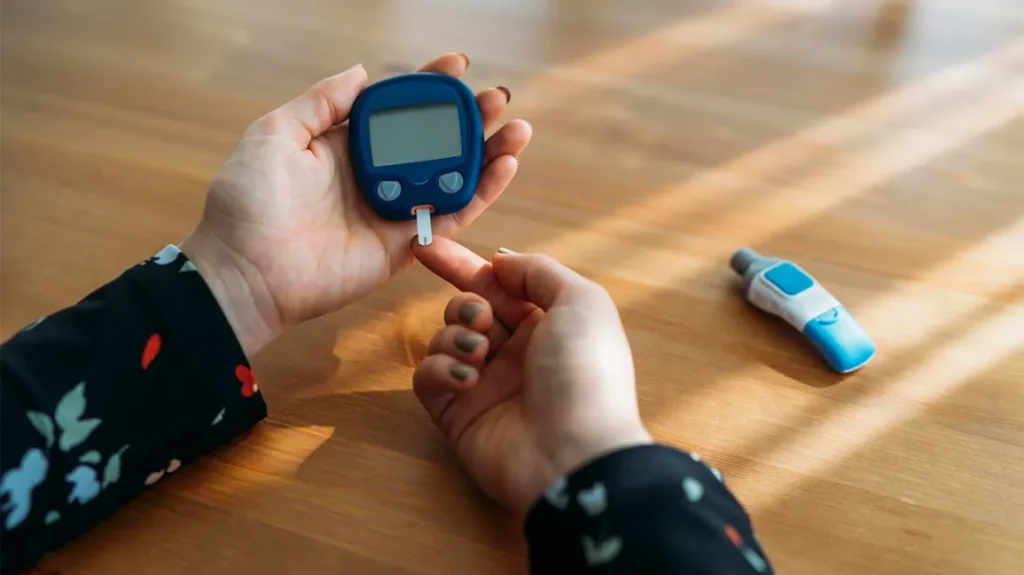Blog
How to Choose the Right Glucometer for Managing Diabetes
Managing diabetes effectively requires regular monitoring of blood glucose levels, and a reliable glucometer is a cornerstone of that process. With a wide variety of glucometers available on the market, selecting the right one can feel overwhelming. The ideal glucometer should align with your lifestyle, health needs, and preferences while providing accurate readings and user-friendly features.
In this comprehensive guide, we’ll explore how to choose the right glucometer for managing diabetes, key features to consider, and the top options available today.
1. What Is a Glucometer and Why Is It Important?
A glucometer, or blood glucose meter, is a portable device designed to measure blood sugar levels. It is an essential tool for individuals with diabetes to monitor and manage their condition effectively.

Key Benefits of a Glucometer:
- Accurate Monitoring: Tracks blood sugar trends to maintain healthy glucose levels.
- Immediate Feedback: Provides real-time results for better decision-making.
- Improved Diabetes Management: Helps prevent complications like hyperglycemia and hypoglycemia.
- Personalized Insights: Data collected can be shared with healthcare providers for tailored treatment plans.
2. Factors to Consider When Choosing a Glucometer
Not all glucometers are the same, and the best one for you will depend on your specific needs. Here are the key factors to consider:
1. Accuracy and Reliability
- Why It Matters: Accurate readings are crucial for making informed decisions about diet, medication, and lifestyle.
- What to Look For: Check for devices approved by regulatory bodies like the FDA or those meeting ISO standards.
2. Ease of Use
- Why It Matters: A complicated device can discourage regular use.
- What to Look For: Choose a glucometer with a simple interface, clear instructions, and easy-to-read displays.
3. Blood Sample Size and Testing Time
- Why It Matters: Smaller blood samples and faster results make the process more convenient.
- What to Look For: Devices requiring minimal blood (e.g., 0.3–0.5 microliters) and providing results within 5 seconds.
4. Portability
- Why It Matters: Compact and lightweight glucometers are easier to carry, especially for those with an active lifestyle.
- What to Look For: Small, travel-friendly designs with durable cases.
5. Connectivity and Data Storage
- Why It Matters: Tracking trends over time helps with long-term diabetes management.
- What to Look For: Glucometers with Bluetooth or app integration, allowing you to sync and analyze data on your smartphone.
6. Test Strip Availability and Cost
- Why It Matters: Strips can be an ongoing expense, and availability is crucial for regular monitoring.
- What to Look For: Choose a device with affordable and easily accessible test strips.
7. Advanced Features
- Why It Matters: Additional features can enhance usability and insights.
- What to Look For: Consider options with features like voice guidance, backlit screens, or meal tagging.
8. Insurance Coverage
- Why It Matters: Some insurance plans cover specific glucometer brands and strips.
- What to Look For: Verify coverage with your provider to minimize out-of-pocket costs.
3. Top Features to Look for in a Glucometer
Here are the must-have features that ensure your glucometer meets your needs:
1. Memory and Data Tracking
- Stores past readings for easy reference.
- Helpful for identifying patterns and trends.
2. Alternate Site Testing
- Allows testing from areas other than fingertips, such as the palm or forearm, for greater comfort.
3. Automatic Coding
- Eliminates the need to manually input code for test strips, reducing errors.
4. Large Display and Audio Options
- Beneficial for individuals with vision impairments.
5. Multi-User Profiles
- Useful for families or caregivers monitoring multiple individuals.
4. Popular Glucometers and Their Features
Here’s a roundup of some of the best glucometers available today:
1. Accu-Chek Guide
- Features: Compact design, smart lighting for test strip port, and app connectivity.
- Best For: Tech-savvy users who want a reliable device with app integration.
2. OneTouch Verio Reflect
- Features: Personalized insights, blood sugar trend alerts, and color-coded range indicators.
- Best For: Beginners seeking a user-friendly device with detailed guidance.
3. Contour Next One
- Features: High accuracy, Bluetooth-enabled app tracking, and second-chance sampling.
- Best For: Individuals prioritizing accuracy and advanced features.
4. FreeStyle Lite
- Features: No coding required, small blood sample size, and backlit display.
- Best For: Users seeking simplicity and portability.
5. CareTouch Blood Glucose Monitor Kit
- Features: Affordable, includes accessories, and offers fast results.
- Best For: Budget-conscious users needing a complete starter kit.
5. How to Use a Glucometer Effectively
To get the most out of your glucometer, follow these steps:
Step 1: Wash and Dry Your Hands
Clean hands prevent contamination and ensure accurate readings.
Step 2: Insert Test Strip
Place the test strip in the glucometer as per instructions.
Step 3: Prick Your Finger
Use the lancing device to obtain a small drop of blood.
Step 4: Apply Blood to Test Strip
Ensure the blood sample fully covers the test strip’s target area.
Step 5: Read and Record Results
Wait for the reading and log it manually or through the connected app.
Step 6: Dispose of Supplies Properly
Dispose of used test strips and lancets in a sharps container.
6. Tips for Maintaining Your Glucometer

To ensure your glucometer remains reliable:
- Store Properly: Keep it in a cool, dry place away from direct sunlight.
- Clean Regularly: Wipe the device with a soft cloth; avoid submerging it in water.
- Check Batteries: Replace batteries as needed to prevent interruptions.
- Calibrate If Necessary: Some devices require periodic calibration for accuracy.
7. The Role of Glucometers in Diabetes Management
Regular blood sugar monitoring is critical for:
- Preventing Complications: Helps avoid severe highs or lows in glucose levels.
- Adjusting Treatment Plans: Provides data to tailor medication and dietary choices.
- Empowering Patients: Promotes a proactive approach to health.
Glucometers, when used consistently, allow individuals to take charge of their diabetes and improve their quality of life.
8. Future Trends in Glucometers
The future of glucometers is promising, with advancements that enhance usability and accuracy:
1. Continuous Glucose Monitoring (CGM):
- Devices like Dexcom and Freestyle Libre offer real-time glucose tracking without finger pricks.
2. Non-Invasive Glucose Monitoring:
- Emerging technologies aim to measure glucose without blood samples, such as sensors or wearable patches.
3. AI Integration:
- Smart glucometers may soon provide predictive insights and personalized recommendations.
Conclusion
Choosing the right glucometer is a crucial step in managing diabetes effectively. By considering factors like accuracy, ease of use, and advanced features, you can find a device that fits seamlessly into your lifestyle. Whether you prefer a basic model or one with cutting-edge technology, the right glucometer will empower you to monitor your health with confidence.
Invest in a glucometer that meets your needs, and take charge of your diabetes management for a healthier, more balanced life.

